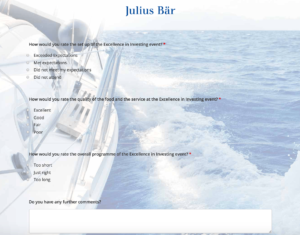Post-event surveys are a great way to better understand your target audience. These surveys can reveal a lot of insights as to what your attendees liked and disliked about your event.
However, like every other form of feedback, post-event surveys may not be adequately designed all the time. The questions asked on the surveys may not be relevant enough to produce useful answers that you can use for the future.
Find some great tips here on how you can design post-event surveys along with other related factors.
What is it?
First, understand what a post-event survey is all about. This may seem obvious but sometimes we may not fully understand the fundamental purpose of a post-event survey.
This leads to poorly designed surveys that are not able to connect with your audience effectively.
A post-event survey is simply a questionnaire that asks for various types of feedback regarding the event. Once you have conducted your event and know who your attendees are, you can send them your post-event survey to ask them what they thought of your event.
This is a powerful tool that you can use to connect with your audience and learn more about your target market.
Benefits of a post-event survey
A post-event survey offers a number of benefits. Some of you may think that these surveys usually get ignored, and the ones that get answered contain responses that are either false or too complicated to understand.
Nevertheless, this depends on how the post-event survey was initially designed. Regardless, post-event surveys still serve as crucial gateways between you and your target audience in terms of opening new pathways for expanding your reach across the market.
A post-event survey not only tells you about what your attendees want or expect from your events in the future, but it also acts as an incentive for the attendees to attend any subsequent events that you may conduct. The act of asking your customers about their likes and dislikes makes them feel valued. A survey allows you to convert one-time attendees into regular clients who keep coming back for more.
How to use it for future events
As mentioned earlier, a post-event survey reveals critical information about the target market and allows you to improve your services.
In principle, such surveys give you ideas on the action points that you need to work on.
Once you have enough information, begin devising better strategies to promote your event. You will also be able to incorporate crucial elements in your event that your attendees found most attractive.
You can also use the information gained as a way to reduce your costs. This is because surveys give you a lot of insights on what your customers want. Your promotion activities can then become more specific and efficient through the use of these insights, thereby reducing your costs in the future.
Surveys also provide statistical data that you can use to analyze in order to better manage your revenues, expenses and other aspects of your event.
How to begin
Designing a post-event survey may seem like an overwhelming task at first. The following useful guidelines will help you in creating meaningful postoperative surveys.
The first thing you need to know is that a post-event survey introduction needs to be short and catchy so that respondents are prompted to read further.
Secondly, the less amount of open-ended questions you have, the better. Open-ended questions may result in ambiguous answers which are difficult to understand.
Begin by asking simple yes or no questions, for example, ask whether they liked the food or speakers for the day.
Next, include some questions that require respondents to rate a particular aspect of your event. You could include a question that says “On a scale of 1 to 5, with 1 being the lowest and 5 being the highest, how convenient was the ticketing system for the event?”
Offer Incentives for Submission
Respondents will be much more willing to respond to a survey if they are offered incentives.
One suggestion is to give them a discount off tickets for the next event that you’re organizing.
Post-Event Feedback Survey Template
A post-event survey template can help you get started with your survey design.

Remember to tailor your survey according to your target market though.
5 post-event survey questions to avoid
Below are some questions that are either annoying or may cause your respondents to lose interest. Avoid the following at all costs.
1. Leading questions
How good was the event for you?
This is a leading question and can jeopardize your survey results by skewing a respondent’s answer.
2. Questions that are open-ended
What did you like and dislike about the event?
It is better to provide options to make it easier to answer. Be specific for targeted results.
3. Double-edged questions
How happy or unhappy were you with golfing and bowling?
This can produce biased results since many respondents may only talk about one activity and ignore the other. This could affect your survey results.
4. Complicated questions
Make sure your questions are simple and easy to understand. No need to ask too complex questions that cause respondents to drop out halfway.
5. Questions that require assumptions
Questions that require the respondent to assume a certain situation can produce ambiguous results since assumptions may be inaccurate or irrelevant altogether.
Conclusion
Designing a post-event survey can indeed be a tedious task. However, with the guidance is given above and amazing tools that Gevme offers for creating surveys, you can instantly build meaningful surveys that allow you to understand your customers better and take your event to the next level
Start using GEVME Survey, which is your tool for building meaningful post-event surveys.








